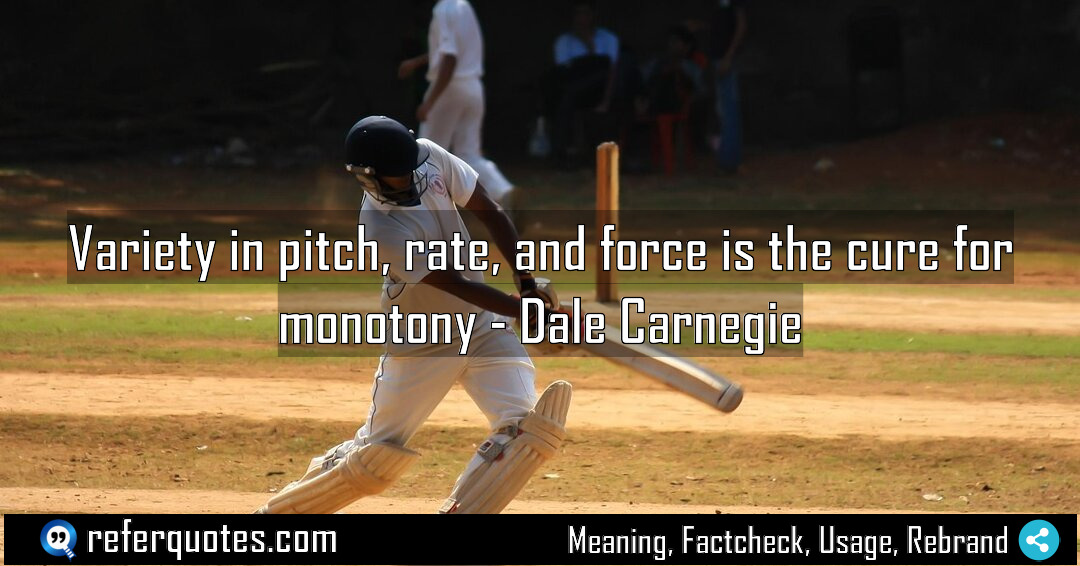
Variety in pitch, rate, and force is the cure for monotony. It’s a simple but powerful truth I’ve seen transform speakers from boring to captivating. This principle is the secret weapon for anyone who needs to hold an audience’s attention.
Share Image Quote:
Table of Contents
Meaning
At its heart, this quote means that the antidote to a boring, monotonous speaking style is to consciously vary your voice’s melody, speed, and power.
Explanation
Look, I’ve coached hundreds of people, and the number one killer of a great message is a flat, unchanging delivery. It’s like serving a five-star meal on a paper plate—it just doesn’t land. Carnegie and Esenwein nailed it by breaking it down into three levers you can control. Pitch is your vocal high and low notes—it’s the melody of your speech. Rate is your speed; slowing down to emphasize a point, speeding up to convey excitement. And force is your volume and power, the punch you give to your key ideas. When you mix these three together, you stop *telling* people information and you start *engaging* them with it. You create a soundscape that’s impossible to ignore.
Quote Summary
Reading Level36
Aesthetic Score56
Origin & Factcheck
This gem comes straight from the classic public speaking manual, “The Art of Public Speaking,” first published in 1915 in the United States. It’s important to note that while we often just say “Dale Carnegie,” the book was actually a collaboration with his colleague Joseph Berg Esenwein. So the credit is shared, which is a nice bit of trivia.
Attribution Summary
Author Bio
Dale Carnegie(1888), an American writer received worldwide recognition for his influential books on relationship, leadership, and public speaking. His books and courses focus on human relations, and self confidence as the foundation for success. Among his timeless classics, the Dale Carnegie book list includes How to Win Friends and Influence People is the most influential which inspires millions even today for professional growth.
Official Website |Facebook | X | Instagram | YouTube |
Where is this quotation located?
| Quotation | Variety in pitch, rate, and force is the cure for monotony |
| Book Details | Publication Year/Date: 1915 (first edition); ISBN/Unique Identifier: 9781420933431 (common Digireads reprint); Last edition. Number of pages: common reprints ~300–480 pages (varies by printing) |
| Where is it? | Part IV Avoiding Monotony, Unverified – Edition 1915, page range ~182–196 |
Context
In the book, this isn’t some abstract artistic idea. It’s presented as a practical, almost mechanical solution. They were teaching a generation that needed to command rooms without microphones, where your voice was your only tool. They framed vocal variety not as a nice-to-have, but as an essential, non-negotiable skill for being understood and believed.
Usage Examples
You see this principle in action everywhere once you start listening for it.
- The Team Leader in a Monday morning meeting, using a faster rate and higher pitch to generate excitement for a new project, then dropping their voice to a slower, more forceful tone to explain the critical deadlines. They’re using vocal variety to guide their team’s emotional response.
- The Salesperson on a final pitch call, who doesn’t just list features. They slow their rate right down and lean in with a quieter, more confidential force when talking about ROI, making the client feel like they’re getting insider information.
- The Teacher explaining a complex concept, who uses a varied pitch, almost like a melody, to make the information more memorable and less like a drone of facts. They’re fighting the monotony that puts students to sleep.
This is for anyone who speaks to others—managers, coaches, pastors, even parents reading a bedtime story.
To whom it appeals?
Share This Quote Image & Motivate
Motivation Score54
Popularity Score69
Shareability Score52
FAQ
Question: Does this mean I have to be overly dramatic or theatrical?
Answer: Not at all. In fact, the goal is natural variety, not performance. It’s about reflecting the natural emotion and emphasis you’d use in a passionate one-on-one conversation. The “monotony” they’re curing is the one we fall into when we’re nervous or reading from a script.
Question: I hate the sound of my own voice. How can I work on this?
Answer: Everyone hates their recorded voice at first! The trick is to record a short talk on your phone and just listen for one thing at a time. First, just listen for pitch. Was I flat? Next time, listen for speed. You diagnose and fix one lever at a time.
Question: Is this still relevant with all our video calls and presentations?
Answer: It’s *more* relevant. On a pixelated screen, with potential lag, your vocal delivery is often the only thing keeping people from switching tabs. A monotone voice on Zoom is a recipe for multitasking.
Similar Quotes
“Forget the idea of balance. Find your rhythm.” This is a game-changing reframe for anyone feeling stuck by the pressure to have it all. Table of Contents Meaning Explanation Origin…
Small changes can produce big results… but the real secret is that the biggest wins are often hiding in plain sight, in the places you’d least expect. Table of Contents…
Simplicity is longevity’s companion isn’t just a nice phrase. It’s a fundamental truth I’ve seen proven time and again in the world’s healthiest communities. It means that a less complicated…
If you want to improve something, the most powerful lever you can pull is to double the frequency of your measurement. It’s a deceptively simple idea that forces a feedback…
Progress isn’t linear; it’s a messy, winding road. This quote from Marc Perry nails the reality that true growth is never a straight line. It’s about embracing the entire journey,…
